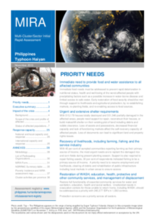Typhoon Haiyan is the most powerful storm ever recorded. It made landfall in the morning of 8 November in Guiuan, Eastern Samar province, causing extensive damage to life, housing, livelihoods and infrastructure across nine of the Philippines’ poorest provinces. The islands of Leyte and Samar were hardest hit: 90 percent of the infrastructure of Leyte’s largest urban center, Tacoloban City, was destroyed. Philippines authorities estimate that 13 million people have been affected, 3.4 million displaced, and at least 5,209 people are confirmed dead.
To better understand the impact of Typhoon Haiyan on affected population, more than 40 agencies conducted a multi-cluster initial rapid assessment (MIRA) providing a broad and coherent overview of the humanitarian needs of the extensive affected areas. It is using a purposive methodology and is designed to be administered at the barangay level utilising key informants. A total of 283 barangays were assessed from 92 municipalities from 9 provinces lying within the direct path of the typhoon. The barangays surveyed do not constitute a representative sample of affected areas so given the limited observations available the map is indicative only and need to be carefully interpreted.
The (MIRA) confirmed that the impacts of Typhoon Haiyan follow a relatively clear geographical pattern. It has devastated essential services in the hardest hit areas, leaving communities without sufficient access to health, water and sanitation, and education. Between 46 and 62 per cent of the health facilities were damaged and unusable after the typhoon in the most affected areas. Many of the main water works of the affected municipalities have either been severely damaged and are non-operational. The majority of the displaced population is highly dependent on unsafe water sources. There is widespread damage to toilet facilities and open defecation is a major source of concern. Education has also been severely impacted by the typhoon with 90 percent of schools damaged in the most highly affected areas. Rehabilitation of community services, including restoration of local government units, is a priority.
The affected population in the worst impacted areas is estimated at 4 million of which 2 million are displaced. They are located along the coastal and inland areas of Leyte, Samar, Eastern Samar, the northern tip of Cebu and Panay Island. Of those displaced, the majority are living in temporary shelter, mostly on or near their own plot of land or destroyed/damaged house. Around 10 per cent of displaced people in these areas also live with host families.
Protection risks must be mitigated especially in evacuation centers where overcrowding and lack of lighting heighten the likelihood of sexual and gender based violence. Child protection, especially for unaccompanied children, is a key concern. The main protection considerations highlighted by affected communities include loss of legal documents, lack of adequate communication between family members and lack of adequate physical protection.
Special attention must be paid to vulnerable segments of the population, such as unaccompanied teenagers and children, the elderly, people with disabilities, and single-headed households with children. These people are particularly at risk of resorting to negative coping strategies, such as sale of remaining assets, reduced food consumption, survival sex, family separation (sending family members elsewhere for work) or begging. Remote/isolated/inaccessible areas and those who have not yet received any food distributions are extremely vulnerable and must be served immediately.

